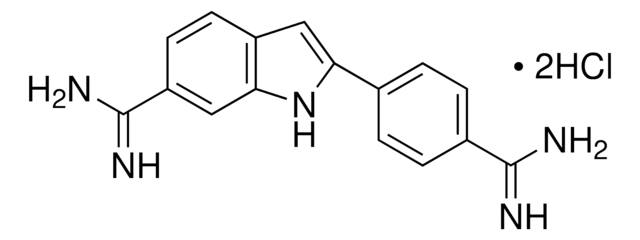ABC505
Anti-hERV-WL Antibody
serum, from rabbit
Synonym(s):
rWL-1, Protein transport protein Sec23B, SEC23-related protein B
Sign Into View Organizational & Contract Pricing
All Photos(2)
About This Item
UNSPSC Code:
12352203
eCl@ss:
32160702
NACRES:
NA.41
Recommended Products
biological source
rabbit
Quality Level
antibody form
serum
antibody product type
primary antibodies
clone
polyclonal
species reactivity
human
technique(s)
flow cytometry: suitable
western blot: suitable
UniProt accession no.
shipped in
wet ice
target post-translational modification
unmodified
Gene Information
human ... SEC23B(10483)
Related Categories
General description
Human endogenous retrovirus (HERV) proviruses comprise a significant part of the human genome, with approximately 98,000 ERV elements and fragments making up nearly 8% of the DNA. All appear to be inactive containing many deletions and nonsense mutations having integrated into the genome likely millions of years ago but left over HERV DNA as played an active role in genome evolution for millions and years and many important genes expressed today have promoters and enhances that have come from HERV DNA sequences. The best studied example is that of the retroviral fusogenic env proteins. In humans, and other mammals, intact env proteins called syncytins are responsible for the formation and function of syncytiotrophoblasts. These multi-nucleated cells are mainly responsible for maintaining nutrient exchange and protecting the developing fetus from the mother′s immune system. The protein HERV-WL is an ancient retroviral envelope (env) protein. This endogenous envelope protein has retained its original fusogenic properties and participates in trophoblast fusion during placenta morphogenesis. HERV-WL gets cleaved into two functional chains upon expression. A surface protein named SU and a transmembrane protein called TM. SU mediates receptor recognition. This interaction triggers the refolding of the transmembrane protein (TM) and is thought to activate its fusogenic potential by unmasking its fusion peptide. The transmembrane protein (TM) acts as a class I viral fusion protein. During viral and target cell membrane fusion, the coiled coil regions (heptad repeats) assume a trimer-of-hairpins structure, positioning the fusion peptide in close proximity to the C-terminal region of the ectodomain. The formation of this structure appears to drive apposition and subsequent fusion of membranes. HERV is expressed during development and in the uterine and placental tissues in the adult.
Immunogen
Recombinant protein corresponding to human ERV-WL.
Application
Detect HERV using this rabbit polyclonal antibody, Anti-hERV-WL Antibody validated for use in western blotting & Flow Cytometry.
Research Category
Apoptosis & Cancer
Apoptosis & Cancer
Research Sub Category
Apoptosis - Additional
Apoptosis - Additional
Western Blotting Analysis: A 1:1,000 dilution from a representative lot detected hERV-WL in Jurkat cell lysate.
Flow Cytometry Analysis: 1 µL from a representative lot detected hERV-WL in 1X10E6 Raji and COS-7 cells.
Flow Cytometry Analysis: 1 µL from a representative lot detected hERV-WL in 1X10E6 Raji and COS-7 cells.
Quality
Evaluated by Western Blotting in Tera-2 cell lysate.
Western Blotting Analysis: A 1:1,000 dilution of this antibody detected hERV-WL in 10 µg of Tera-2 cell lysate.
Western Blotting Analysis: A 1:1,000 dilution of this antibody detected hERV-WL in 10 µg of Tera-2 cell lysate.
Target description
~60 kDa observed
Physical form
Rabbit polyclonal serum in buffer containing 0.05% sodium azide.
Unpurified
Storage and Stability
Stable for 1 year at -20°C from date of receipt.
Handling Recommendations: Upon receipt and prior to removing the cap, centrifuge the vial and gently mix the solution. Aliquot into microcentrifuge tubes and store at -20°C. Avoid repeated freeze/thaw cycles, which may damage IgG and affect product performance.
Handling Recommendations: Upon receipt and prior to removing the cap, centrifuge the vial and gently mix the solution. Aliquot into microcentrifuge tubes and store at -20°C. Avoid repeated freeze/thaw cycles, which may damage IgG and affect product performance.
Disclaimer
Unless otherwise stated in our catalog or other company documentation accompanying the product(s), our products are intended for research use only and are not to be used for any other purpose, which includes but is not limited to, unauthorized commercial uses, in vitro diagnostic uses, ex vivo or in vivo therapeutic uses or any type of consumption or application to humans or animals.
Not finding the right product?
Try our Product Selector Tool.
Storage Class
10 - Combustible liquids
wgk_germany
WGK 1
Certificates of Analysis (COA)
Search for Certificates of Analysis (COA) by entering the products Lot/Batch Number. Lot and Batch Numbers can be found on a product’s label following the words ‘Lot’ or ‘Batch’.
Already Own This Product?
Find documentation for the products that you have recently purchased in the Document Library.
Our team of scientists has experience in all areas of research including Life Science, Material Science, Chemical Synthesis, Chromatography, Analytical and many others.
Contact Technical Service






